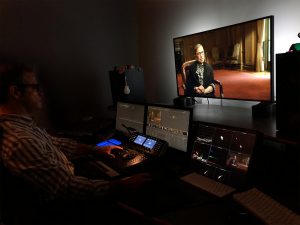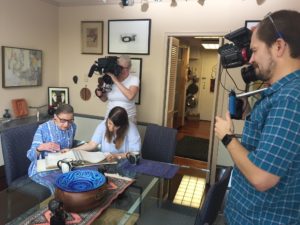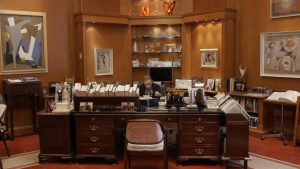- Ken Sirulnick, President of Glue Editing & Design in New York, grading RBG using DaVinci Resolve Studio and a DaVinci Resolve Mini Panel.
- Claudia Raschke and crew filming RBG and her granddaughter.
- Office scene from RBG. Photo courtesy of Magnolia Pictures.
- Photo of the Supreme Court Justices, c. 1993, in RBG, a Magnolia Pictures release. Photo courtesy of Magnolia Pictures.
RBG is everywhere. Streaming, screening, in theaters, on DVD and devices. RBG opened in January 2018 at Sundance Film Festival.
The documentary about Ruth Bader Ginsburg was directed and produced by Betsy West and Julie Cohen. Claudia Raschke was the Cinematographer, working with ARRI Amira, Canon C300 Mark II and Sony F55 cameras—all shot in LOG. Ken Sirulnick, President of Glue Editing & Design in New York, graded the film using DaVinci Resolve Studio and a DaVinci Resolve Mini Panel.
Magnolia Pictures is the distributor. The summary: “At the age of 85, U.S. Supreme Court Justice Ruth Bader Ginsburg has developed a lengthy legal legacy while becoming an unexpected pop culture icon (T-shirts, exercise videos). But the unique personal journey of her rise to the nation’s highest court has been largely unknown, even to some of her biggest fans—until now. RBG explores Ginsburg’s life and career.”
A.O. Scott wrote, in the New York Times, “Ruth Bader Ginsburg was the second woman appointed to the United States Supreme Court, but she’s probably the first justice to become a full-fledged pop-cultural phenomenon. RBG, a loving and informative documentary portrait of Justice Ginsburg during her 85th year on earth and her 25th on the bench, is both evidence of this status and a partial explanation of how it came about.”
Ken Sirulnick was involved early on. He explained, “I wish this happened more often. The filmmakers contacted me during preproduction. I was on board throughout the whole process, helping with decisions about prep, transcoding, storage choices, and the entire post process. So, when the footage came to me, there were no surprises. “
As with many documentaries, there was a lot of archive footage with a variety of frame rates. Before the grading process, everything was converted to 1080p 23.98 using our Alchemist XF at Glue Editing & Design. There was a mix of video and news archive footage ranging from 29.97, 25, 24 and a few other odd frame rates. The converted footage was cut back into the Premiere timeline and then an XML was imported to DaVinci Resolve Studio.
“As with most documentaries, we started by grouping all the interviews together in DaVinci Resolve Studio and graded those first. The entire film was finished in DaVinci Resolve Studio with graphics provided as .png files as well as Apple ProRes4444 animation. Any required image stabilization was done in both Da- Vinci Resolve Studio and Fusion Studio as necessary.
“The final film was exported to 12-bit DNxHR HQX OP1a MXF. The DCP was created with easyDCP on another DaVinci Resolve Studio system with a final QC done in a DI theater.
“We work on many festival films and it is very rewarding when one is as successful as RBG.”
Reprinted from Film and Digital Times September 2018 Edition #89-90












